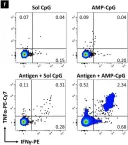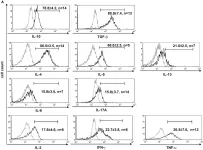Vaccines have curtailed the devastation wrought by COVID-19. Nevertheless, emerging variants result in a high incidence of breakthrough infections. Here we assess the impact of vaccination and breakthrough infection on severe acute respiratory syndrome coronavirus 2 (SARS-CoV-2) T cell immunity. We demonstrate that COVID-19 vaccination induces robust spike-specific T cell responses that, within the CD4+ compartment, display comparable IFN-γ responses to SARS-CoV-2 infection without vaccination. Vaccine-induced CD8+ IFN-γ responses however, were significantly greater than those primed by SARS-CoV-2 infection alone. This increased responsiveness is associated with induction of novel HLA-restricted CD8+ T cell epitopes not primed by infection alone (without vaccination). Despite these augmented responses, breakthrough infection still induced de novo T cell responses against additional SARS-CoV-2 CD8+ epitopes that display HLA-associated immunodominance hierarchies consistent with those in unvaccinated COVID-19 convalescent individuals. This study demonstrates the unique modulation of anti-viral T cell responses against multiple viral antigens following consecutive yet distinct priming events in COVID-19 vaccination and breakthrough infection.
© 2023 The Author(s).
Product Citations: 54
Breakthrough SARS-COV-2 infection induces broad anti-viral T cell immunity.
In IScience on 15 December 2023 by Lineburg, K. E., Crooks, P., et al.
-
COVID-19
-
Immunology and Microbiology
In Nature Communications on 30 November 2023 by Shetab Boushehri, S., Essig, K., et al.
Therapeutic antibodies are widely used to treat severe diseases. Most of them alter immune cells and act within the immunological synapse; an essential cell-to-cell interaction to direct the humoral immune response. Although many antibody designs are generated and evaluated, a high-throughput tool for systematic antibody characterization and prediction of function is lacking. Here, we introduce the first comprehensive open-source framework, scifAI (single-cell imaging flow cytometry AI), for preprocessing, feature engineering, and explainable, predictive machine learning on imaging flow cytometry (IFC) data. Additionally, we generate the largest publicly available IFC dataset of the human immunological synapse containing over 2.8 million images. Using scifAI, we analyze class frequency and morphological changes under different immune stimulation. T cell cytokine production across multiple donors and therapeutic antibodies is quantitatively predicted in vitro, linking morphological features with function and demonstrating the potential to significantly impact antibody design. scifAI is universally applicable to IFC data. Given its modular architecture, it is straightforward to incorporate into existing workflows and analysis pipelines, e.g., for rapid antibody screening and functional characterization.
© 2023. The Author(s).
-
FC/FACS
-
Immunology and Microbiology
-
Neuroscience
In Immunotherapy Advances on 28 August 2023 by Lin, M., Bhakdi, S. C., et al.
Recurrence of hepatitis B virus-related hepatocellular carcinoma (HBV-HCC) after liver transplant (LT) is mediated by circulating tumour cells (CTCs) and exacerbated by the immunosuppressants required to prevent graft rejection. To circumvent the effects of immunosuppressants, we developed immunosuppressive drug-resistant armoured HBV-specific T-cell receptor-redirected T cells (IDRA HBV-TCR). However, their ability to eliminate HBV-HCC circulating in the whole blood has never been tested, and whether their lytic efficacy is compatible with the number of adoptively transferred T cells in vivo has never been measured. Hence, we developed a microscopy-based assay to quantify CTCs in whole blood. The assay was then used to quantify the efficacy of IDRA HBV-TCRs to lyse free-floating HBV-HCC cells in the presence of Tacrolimus and Mycophenolate Mofetil (MMF). We demonstrated that a panel of antibodies (AFP, GPC3, Vimentin, pan-Cytokeratin, and CD45) specific for HCC tumour antigens and immune cells can effectively differentiate HCC-CTCs in whole blood. Through dose-titration experiments, we observed that in the presence of immunosuppressive drugs, a minimum of 20 000 IDRA HBV-TCR T cells/ml of whole blood is necessary to lyse ~63.5% of free-floating HBV-HCC cells within 16 hours. In conclusion, IDRA HBV-TCR T cells can lyse free-floating HBV-HCC cells in whole blood in the presence of Tacrolimus and MMF. The quantity of IDRA-HBV TCR T cells required can be achieved by the adoptive transfer of 5 × 106 IDRA-HBV TCR-T cells/kg, supporting the utilisation of IDRA HBV-TCR T cells to eliminate CTCs as prophylaxis against recurrence after LT.
© The Author(s) 2023. Published by Oxford University Press on behalf of the British Society for Immunology.
-
Homo sapiens (Human)
-
Cardiovascular biology
-
Immunology and Microbiology
In Nature Communications on 8 August 2023 by Dasari, V., McNeil, L. K., et al.
The recent emergence of a causal link between Epstein-Barr virus (EBV) and multiple sclerosis has generated considerable interest in the development of an effective vaccine against EBV. Here we describe a vaccine formulation based on a lymph node targeting Amphiphile vaccine adjuvant, Amphiphile-CpG, admixed with EBV gp350 glycoprotein and an engineered EBV polyepitope protein that includes 20 CD8+ T cell epitopes from EBV latent and lytic antigens. Potent gp350-specific IgG responses are induced in mice with titers >100,000 in Amphiphile-CpG vaccinated mice. Immunization including Amphiphile-CpG also induces high frequencies of polyfunctional gp350-specific CD4+ T cells and EBV-specific CD8+ T cells that are 2-fold greater than soluble CpG and are maintained for >7 months post immunization. This combination of broad humoral and cellular immunity against multiple viral determinants is likely to provide better protection against primary infection and control of latently infected B cells leading to protection against the development of EBV-associated diseases.
© 2023. The Author(s).
-
FC/FACS
-
Mus musculus (House mouse)
-
Immunology and Microbiology
TMEM123 a key player in immune surveillance of colorectal cancer.
In Frontiers in Immunology on 10 July 2023 by Pesce, E., Cordiglieri, C., et al.
Colorectal cancer (CRC) is a leading cause of cancer-associated death. In the tumor site, the interplay between effector immune cells and cancer cells determines the balance between tumor elimination or outgrowth. We discovered that the protein TMEM123 is over-expressed in tumour-infiltrating CD4 and CD8 T lymphocytes and it contributes to their effector phenotype. The presence of infiltrating TMEM123+ CD8+ T cells is associated with better overall and metastasis-free survival. TMEM123 localizes in the protrusions of infiltrating T cells, it contributes to lymphocyte migration and cytoskeleton organization. TMEM123 silencing modulates the underlying signaling pathways dependent on the cytoskeletal regulator WASP and the Arp2/3 actin nucleation complex, which are required for synaptic force exertion. Using tumoroid-lymphocyte co-culture assays, we found that lymphocytes form clusters through TMEM123, anchoring to cancer cells and contributing to their killing. We propose an active role for TMEM123 in the anti-cancer activity of T cells within tumour microenvironment.
Copyright © 2023 Pesce, Cordiglieri, Bombaci, Eppenberger-Castori, Oliveto, Manara, Crosti, Ercan, Coto, Gobbini, Campagnoli, Donnarumma, Martinelli, Bevilacqua, De Camilli, Gruarin, Sarnicola, Cassinotti, Baldari, Viale, Biffo, Abrignani, Terracciano and Grifantini.
-
Cancer Research
-
Immunology and Microbiology
In Nat Commun on 8 August 2023 by Dasari, V., McNeil, L. K., et al.
Fig.4.F

-
FC/FACS
-
Mus musculus (House mouse)
Collected and cropped from Nat Commun by CiteAb, provided under a CC-BY license
Image 1 of 3
In Nat Commun on 8 August 2023 by Dasari, V., McNeil, L. K., et al.
Fig.4.B

-
FC/FACS
-
Mus musculus (House mouse)
Collected and cropped from Nat Commun by CiteAb, provided under a CC-BY license
Image 1 of 3
In Front Immunol on 25 February 2015 by Ziegler, H., Welker, C., et al.
Fig.3.A

-
FC/FACS
-
Homo sapiens (Human)
Collected and cropped from Front Immunol by CiteAb, provided under a CC-BY license
Image 1 of 3


